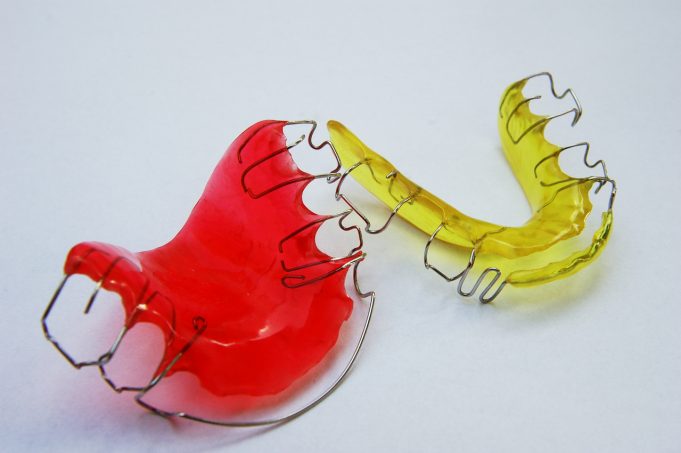Congratulations, the braces are off! But although the hard work of shifting and aligning teeth might be complete, the next phase of orthodontic treatment is no less important.
Now it’s about keeping those fresh, smooth, pearly whites in their rightful position and chances are your orthodontist has furnished you with a retainer to assist.
Wearing a retainer is the final stage of most braces’ treatment, and it’s not only critical you wear this appliance as advised, you should also treat it with great care.
Here are our top tips for taking care of your retainer.
What is a retainer?
A retainer is just as it sounds. It’s a device that helps “retain” the position of teeth. Retainers come in a variety of forms.
Removable retainers
For some people, removable retainers are the favoured option. These appliances are made from a combination of plastic-like material and steel that is inserted into the upper or lower jaw.
They are called removable retainers because they’re the type you put in and take out. In most cases the plastic component is pink to resemble the look of your mouth and this bit sits neatly against the palate. Meanwhile, the steel goes across the front of your teeth to hold them in position.
There are also clear removable retainers available which resemble the look of Invisalign’s clear aligners. They are shaped to the teeth and cover them entirely.
Permanent retainers
In other cases, retainers involve adhering a wire to the back of the teeth to help keep them in position. This is often the option preferred for the lower teeth, but it can be employed on the upper teeth as well. This type of retainer cannot be removed.
Wear as advised
If you have been given a removable retainer, it is imperative you wear it as advised. This stops the teeth from shifting back into their previous position.
If it helps, consider this:
Shifting teeth is a delicate process that sees a series of changes occur in the jaw and bone structure beyond what you can see. For example, while wearing braces, gradual pressure was applied to your teeth to help move them into position. This also resulted in changes in the periodontal structures of your jaw that holds your teeth.
Throughout treatment, bone on one side of a tooth was broken down (resorption), while additional bone mass was created on the other side (deposition). Long after your teeth appeared straight, braces helped continue this process.
Retainers continue this further, by keeping teeth in position while the body works to rebuild the jaw foundations beneath.
It might be useful to view it a bit like construction. As the concrete foundations of your jaw continue to set after braces, the retainer is the scaffolding that keeps your teeth in their correct position.
Just as that scaffolding is imperative to a perfect finish, so too is your retainer!
Removable retainer care
Not only is your retainer valuable in monetary terms, any breakages or issues can result in delays in the orthodontic process at best, or at worst see your teeth begin to shift back into their former position.
In other words, although it’s small, look after it well.
When your retainer is not in your mouth it should be in its case.
- Carry a case with you at all times
- Never wrap your retainer in a napkin – it’s too easy to throw away
- Do not put your retainer in your pocket, where it could be damaged
- Don’t put your retainer in your purse or bag, where it could also be damaged
- Keep your retainer away from pets. There’s been more than one occasion where a dog consumed a retainer!
- Don’t subject your retainer to heat. Avoid leaving it on the dashboard of a car or near heaters.
Cleaning your removable retainer
Your removable retainer should be kept clean. This involves brushing it before it is inserted and after it is removed.
Permanent retainer care
Looking after permanent retainers involves similar diligence to when you had braces. Make sure you take extra time to clean your teeth thoroughly and use the recommended strategies or implements to clean the surface of your teeth beneath the wires and between the orthodontic cement.
Likelihood is, your orthodontist will also recommend regular visits to check your permanent and removable retainers. It’s important you stick to these appointments to ensure plaque is not building up beneath the appliance on your teeth.
If your retainer breaks
If your retainer breaks, it is critical you consult your orthodontist sooner rather than later, otherwise It could undo months of hard work.
Meanwhile, also consult your orthodontist if you’re having problems inserting a removable retainer or should you feel your teeth are beginning to shift.
It’s down to you
The beauty of a retainer is it often signals the conclusion of orthodontic work, but the effectiveness of this final campaign comes down to diligence and wearing your retainer as required.
About Norwest Orthodontics
Norwest Orthodontics specialises in helping you achieve a great smile, no matter your age. We feature a range of orthodontic treatments that span from early intervention right through to remedial adult work.
We also have a suite of treatments available that include discreet, removeable Invisalign braces, and welcome the opportunity to work with you to achieve the smile you’ve always dreamed of.
You can learn more about our services, or contact us here to make an appointment here.




